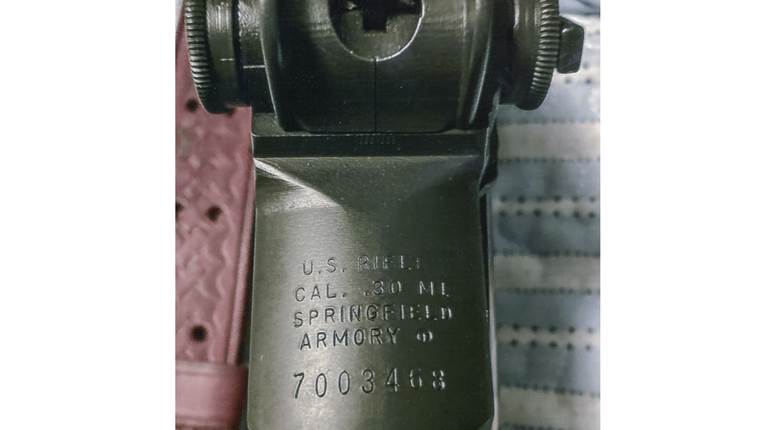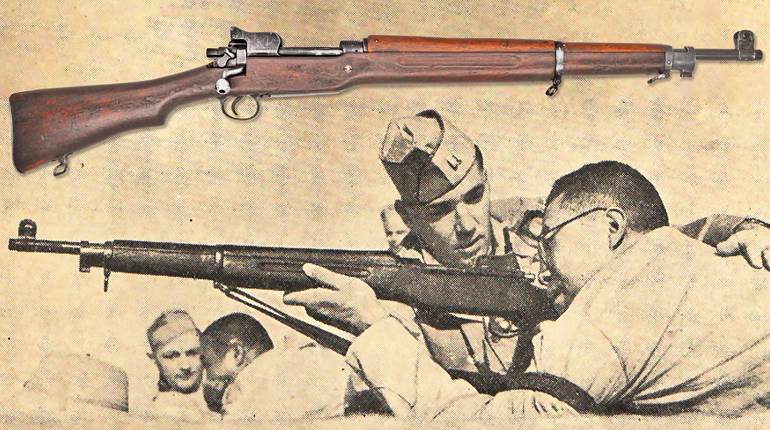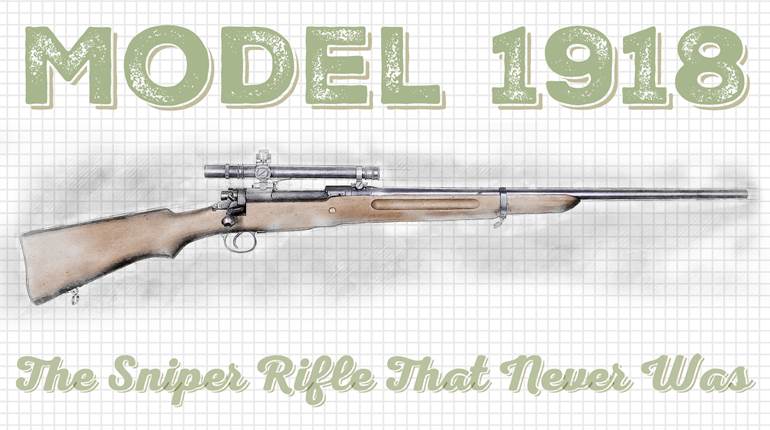
U.S. Marine paratroopers of the 1st Parachute Regiment string communication wire on Bougainville while armed with a Model of 1941 Johnson Rifle (l.) and a Model of 1941 Johnson Light Machine Gun (r.).
The standardized American service rifle during World War II was the M1 Garand. But another semi-automatic rifle—the Model of 1941 Johnson—was also procured during the war by the United States, but its story was markedly different from that of the M1. More than 4 million M1 rifles were manufactured by 1945, and all branches of the U.S. military used Garands in all theaters of the war. In contrast, the number of Johnson rifles acquired by the United States during the war numbered in the hundreds, and it was only issued to a specific U.S. Marine Corps unit. The rifle was purged from the USMC inventory before the end of World War II. Nevertheless, it is one of the more interesting and enigmatic military rifles of the war.
The inventor of the Johnson rifle, Melvin Maynard Johnson, Jr., was a Boston attorney from a prosperous and politically connected New England family. Johnson was also a Marine Corps Reserve captain who had a passion for firearms. He was a vocal critic of the newly adopted M1 Garand, which he believed was a badly flawed design. Johnson developed a recoil-operated firearm mechanism he believed to be superior to the Garand’s gas-operated system. He began refining the mechanism for use in a semi-automatic rifle and a light machine gun. After raising funds to have a couple of prototypes built, Johnson was able to persuade the U.S. Army Ordnance Dept. to hold an informal test of his rifle in June 1938.

The Johnson rifle performed relatively well in the tests but, like any arm still being developed, a number of weaknesses were noted. After enumerating the problems, the Ordnance Dept. politely declined any further interest in the Johnson rifle and considered the matter closed. Not one to take no for an answer, Johnson was able to use his family’s political influence to persuade friendly U.S. congressmen to hold hearings to determine if the Johnson rifle should be adopted as the standard American military service rifle instead of the Garand, which was undergoing its own set of problems at the time. The gambit failed. In order for the Johnson rifle to have had even a remote chance of replacing the Garand, it would have to have been demonstrably and unquestionably superior. It wasn’t.
Johnson turned to other nations in an attempt to market his semi-automatic rifle and light machine gun. After being turned down by several countries, Johnson was finally able to interest representatives of the Netherlands Purchasing Commission (NPC) in his rifle and light machine gun. The NPC needed modern guns to arm the colonial forces in the Dutch East Indies, which was the source of much of the world’s supply of rubber, oil and coffee.
On Aug. 19, 1940, the NPC placed an initial contract for 10,200 Johnson semi-automatic rifles and 515 Johnson light machine guns along with the necessary spare parts and accessories. Both were to be chambered for the .30-’06 Sprg. cartridge. The Dutch order was certainly welcome news to the struggling Johnson Automatics, Inc., organization. A subsequent contract for an additional 10,200 Johnson rifles was placed by the NPC for a total of 20,400 rifles ordered by the Dutch. Since the Johnson organization had no production facilities, an idle textile plant in Cranston, R.I., was acquired and the “Cranston Arms Company” was formed. Both the rifle and light machine gun to be made under the Dutch contracts were designated as the “Model of 1941.”
A signature feature of Johnson’s recoil-operated mechanism was that the barrel moved forward and backward as the gun was fired. That made the use of a standard bayonet problematic, as the added weight would not permit the barrel to recoil properly. To get around the problem, Johnson designed a very lightweight triangular-blade, all-metal bayonet that allowed the rifle to fire with the bayonet attached. However, this resulted in a bayonet that had little utility on, or off, the rifle, but it did satisfy the design parameters, which called for a bayonet.

The Johnson rifles were serially numbered in three separate blocks—number only with no letter prefix, “A” prefix and “B” prefix. The rifles were not assembled in sequential serial number order. Interestingly, most of the parts were also serially numbered. but according to factory records, there was no attempt made to match the serial number of the parts with the number on the receiver.
A total of 21,988 Model of 1941 Johnson rifles were manufactured by the time production ceased, which was 1,588 rifles more than the Dutch ordered. It was not unusual for manufacturers to make a number of arms beyond the contracted sum in the order to have additional guns available for other customers or in the event the original contractee decided to acquire more guns. In this case, the Johnson company sold 1,000 Model 1941 rifles in 7x57 mm Mauser to the government of Chile, which accounted for almost two-thirds of the overruns.
Not long after the initial shipments of the Johnson rifles and light machine guns left the Rhode Island plant, the East Indies fell to the Japanese onslaught, and the balance of the guns was embargoed in the United States. Only about 3,000 Johnson rifles had been shipped prior to the embargo.
A unique feature of the Johnson rifle and light machine gun was the fact that the barrels could be quickly and easily removed. This attracted the attention of the U.S. Marine Corps, which was then in the process of organizing its fledging parachute units. The Marines, though, showed more interest in the Johnson Light Machine Gun than the rifle, and purchased a limited number of the machine guns from the NPC’s embargoed inventory.
The Marine 1st Parachute Battalion was preparing to depart for overseas combat action in the Solomon Islands accompanied by a variety of arms, including 87 Model of 1941 Johnson Light Machine Guns and 565 Model 55 Reising submachine guns. Although the Marines had not yet decided on the procurement of any Johnson rifles, Melvin Johnson “unofficially donated” 23 Model of 1941 rifles to the unit. Johnson later stated that the rifles were provided on “… more or less lend-lease which developed into a gift.” Marine paratrooper Capt. (later Lt. Col.) Harry Torgerson stated that these rifles were used by “select scout-snipers” during the Guadalcanal campaign.
While the handful of Johnson rifles obviously wasn’t a huge part of the Marines’ armament, the gun acquitted itself very well in the limited combat role it played during the campaign. One of the more notable achievements was related in a Dec. 1, 1942, Look magazine article that detailed the exploits of Platoon Sgt. Harry M. Tully of the 1st Parachute Battalion, who was awarded a Silver Star when he used his Johnson rifle to kill 42 Japanese on Gavutu at ranges up to 800 yds.
In October 1942, the Marine Corps 2nd Parachute Battalion requested Johnson rifles. Since all of the available Johnson rifles were the property of the Dutch government, it was necessary to obtain its permission for procurement. It is not known why the 2nd Parachute Battalion and not the 1st Parachute Battalion (which had previously received the 23 rifles from Melvin Johnson) requested the Johnson rifles. In any event, the request was approved, and on Oct. 7, 1942, 650 Model of 1941 Johnson rifles were shipped to the Marine Corps Quartermaster at the Fleet Marine Force in San Diego, Calif. It is interesting to note that none of the rifles were inspected by the Marines prior to shipment.
After being withdrawn from Guadalcanal, the 2nd Parachute Battalion was posted to Titahi Bay, New Zealand, for refitting and additional training. Presumably, this was when the unit received the Johnson rifles that had been shipped in October 1942.
Not wanting to be left off the Johnson rifle bandwagon, the 3rd Parachute Battalion also wanted the same number of rifles that had been sent to the 2nd Parachute Battalion. However, this request was denied primarily due to the NPC’s refusal to release any more of the Johnson rifles because of concerns about the safety of the guns based on the failure of many guns to pass NPC inspection procedures.
On April 1, 1943, the 1st Parachute Regiment was formed from the 1st, 2nd and 3rd Parachute Battalions as part of the First Marine Amphibious Corps. Although the Marine paratroopers were never deployed in combat via parachute, they did make at least one training jump in the Pacific with their Johnson rifles. The Marine paratroopers saw extensive combat action in the Solomon Islands campaign, including Guadalcanal, Vella La Vella and Bougainville, and were employed in much the same manner as the Marine Raiders.
The Table of Organization and Equipment (TO&E) for the 1st Parachute Regiment listed an authorized allowance of 242 Model of 1941 Johnson rifles. These rifles were all from the lot of 650 previously shipped to the 2nd Parachute Battalion. The remaining 408 Johnson rifles (650-242) were presumably never issued. The 1st Parachute Regiment was the only U.S. military unit to have Johnson rifles officially issued and reflected in its unit TO&E. It is often claimed that the Johnson rifles were also used by U.S. Marine Raider units, but that is not correct. Of course, there could have been isolated instances when a Johnson rifle was taken from a wounded or killed Marine paratrooper by a Marine in another (non-airborne) unit, but there was no official issuance to any unit other than the 1st Parachute Regiment.
The 1st Parachute Regiment Johnson rifles saw their most extensive use during the brutal and difficult Bougainville campaign. After the hard-fought Choiseul operation on Bougainville, Lt. Col. Victor Krulak authored a report to the commandant of the Marine Corps regarding the arms used by his Marine paratroopers during the battle. Regarding the Johnson rifle, Krulak stated: “Johnson Rifle, caliber .30. Performed similarly with the M-1. Found little difference between the two.” Given the reputation that the M1 Garand had garnered in combat, Krulak obviously held the Johnson rifle in high regard.

While the Johnson rifles issued to the 1st Parachute Regiment were standard Dutch-production guns, a number of the rifles subsequently had the protective “ears” on the front sight ground off. While documentation to confirm the reason for this modification has not been found, it can be speculated that removing the ears from the front sight resulted in a single blade that would make the sight picture similar to that of the ’03 Springfield rifle, with which the Marines would have been very familiar due to its use in basic training. However, it has not been confirmed that all the 1st Parachute Regiment Johnson rifles had this modification, and a number may have retained the original, unmodified front sight.
After the conclusion of the Bougainville campaign, the 1st Parachute Regiment was officially deactivated, and the paratroopers were ordered to turn in their Johnson rifles. The deactivation of the Marine Corps parachute units meant that there would be no further need for Johnson rifles, and they would no longer be items of issue within the Marine Corps. The refusal of the Netherlands Purchasing Commission to release any more Johnson rifles to the Marines due to the ongoing delays in Johnson Automatics, Inc., rectifying the mechanical problems with them, along with the fact that standardized arms, such as M1 Garand rifles, M1/M1A1 carbines and Browning Automatic Rifles were available, rendered moot the necessity to continue efforts to procure additional Johnson rifles.
The deactivation of the 1st Parachute Regiment and the order to “… eliminate Johnson weapons from Marine Corps requirements” marked the end of the Johnson rifle as a Marine Corps arm. Marine paratrooper Clifford Goodin described the ignoble fate of some of the 1st Parachute Regiment’s Johnson rifles: “When our campaign on Bougainville was over, we were told to gather up all Johnson rifles in our outfit and dispose of them (about 16 as I recall). We took off the barrels and buried them on the beach on Bougainville … I broke my rifle down and put it in a jump bag. Later we had to climb up a rope ladder on the U.S.S. President Jackson and were on our way home. When we reached San Diego, Cal., I sent my weapon home.”
Other members of the 1st Parachute Regiment have related similar experiences with being ordered to bury their Johnson rifles on the beach at Bougainville. The remaining 1st Parachute Regiment Johnsons that were not buried or otherwise disposed of “in theater” were turned in and sent back to the United States to be returned to the Dutch government, where they subsequently saw use with the Dutch Royal Marines and navy.

Although only 650 Johnson rifles were shipped to the 2nd Parachute Battalion, Marine Corps documentation confirms that a total of 750 of the rifles were procured. The origin of the additional 100 rifles has not been discovered, but a clue lies in a Feb. 12, 1945, invoice stating that the Depot of Supplies, U.S. Marine Corps, sold one hundred “Johnson, Semi-Automatic Rifles, .30 Cal. Rotary Feed Model, Used, Serviceable” to Johnson Automatics, Inc., for $5,000 ($50 per rifle). The Johnson company subsequently advertised these rifles for sale to “members of the National Rifle Association only” for $250 each via an advertisement in a 1946 issue in The American Rifleman magazine. Reportedly, the guns sold out very quickly even though that would equate to a 2018 inflation-adjusted per unit price of over $3,500. While a tidy profit indeed for the Johnson company, collectors today will pay several times that amount for an original Model of 1941 Johnson rifle with a confirmed USMC provenance.
While the “holy grail” for a collector would be to obtain an example of one of the 750 Johnson rifles procured by the U.S. Marine Corps in World War II (or one of the 23 “lent” to the 1st Parachute Battalion by Melvin Johnson), there is no known comprehensive serial number roster of these rifles. Therefore, in the absence of some convincing documentation, there is no way to positively identify one of the USMC-used rifles. The guns were not in any particular serial number range or sequence, and examples from all three “blocks” (no prefix, “A” prefix and “B” prefix) are known to have been procured by the Marine Corps. They also bore no special markings to denote USMC ownership. The fact that only 773 of the 21,988 Johnson rifles manufactured were acquired by the Marine Corps means the probability of any particular undocumented example being one of the coveted USMC rifles is about 3 percent—not very good odds! Contrary to what is sometimes claimed, there was never any such thing as a special “Marine Corps” Model of 1941 Johnson rifle. Yes, some were acquired by the Marine Corps, but they were manufactured under contract for the Dutch government and were the same as any other Model of Johnson rifle.
While it would be a stretch to refer to the Johnson rifle as a failure, it never reached its full potential due to some laxness in the manufacturing process and the fact that it was not superior to the standardized M1 Garand. On the other hand, while its use as a U.S. military arm was very limited, the majority of the Marine paratroopers who had occasion to use the rifle in combat were generally pleased with it. Despite its limitations and the rather negligible role it played in World War II, the Model of 1941 Johnson rifle is an extremely interesting arm that continues to elicit a lot of interest even today.
Additional Reading:
Game Changer: The Johnson Auto-Carbine





































